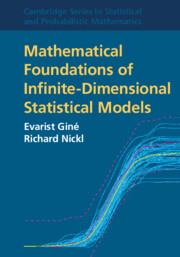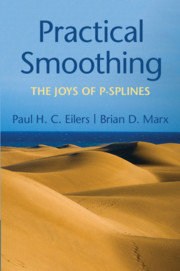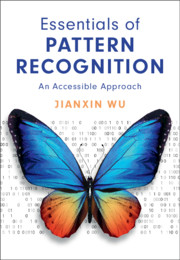Refine search
Actions for selected content:
2327 results in Pattern Recognition and Machine Learning
7 - Signal Regression
-
- Book:
- Practical Smoothing
- Published online:
- 25 February 2021
- Print publication:
- 18 March 2021, pp 114-130
-
- Chapter
- Export citation

Mathematical Foundations of Infinite-Dimensional Statistical Models
-
- Published online:
- 05 March 2021
- Print publication:
- 25 March 2021

Practical Smoothing
- The Joys of P-splines
-
- Published online:
- 25 February 2021
- Print publication:
- 18 March 2021

Essentials of Pattern Recognition
- An Accessible Approach
-
- Published online:
- 08 December 2020
- Print publication:
- 19 November 2020
-
- Textbook
- Export citation
14 - Markov Networks
- from Part V - Probabilistic Graphical Models
-
- Book:
- Data-Driven Computational Neuroscience
- Published online:
- 05 November 2020
- Print publication:
- 26 November 2020, pp 547-572
-
- Chapter
- Export citation
Color plates
-
- Book:
- Data-Driven Computational Neuroscience
- Published online:
- 05 November 2020
- Print publication:
- 26 November 2020, pp 691-714
-
- Chapter
- Export citation
Part V - Probabilistic Graphical Models
-
- Book:
- Data-Driven Computational Neuroscience
- Published online:
- 05 November 2020
- Print publication:
- 26 November 2020, pp 487-488
-
- Chapter
- Export citation
Contents
-
- Book:
- Data-Driven Computational Neuroscience
- Published online:
- 05 November 2020
- Print publication:
- 26 November 2020, pp vii-x
-
- Chapter
- Export citation
Bibliography
-
- Book:
- Data-Driven Computational Neuroscience
- Published online:
- 05 November 2020
- Print publication:
- 26 November 2020, pp 613-678
-
- Chapter
- Export citation
Part III - Probabilistic Inference
-
- Book:
- Data-Driven Computational Neuroscience
- Published online:
- 05 November 2020
- Print publication:
- 26 November 2020, pp 199-200
-
- Chapter
- Export citation
11 - Non-probabilistic Clustering
- from Part IV - Unsupervised Classification
-
- Book:
- Data-Driven Computational Neuroscience
- Published online:
- 05 November 2020
- Print publication:
- 26 November 2020, pp 437-468
-
- Chapter
- Export citation
10 - Multidimensional Classifiers
- from Part III - Probabilistic Inference
-
- Book:
- Data-Driven Computational Neuroscience
- Published online:
- 05 November 2020
- Print publication:
- 26 November 2020, pp 415-434
-
- Chapter
- Export citation
Part II - Statistics
-
- Book:
- Data-Driven Computational Neuroscience
- Published online:
- 05 November 2020
- Print publication:
- 26 November 2020, pp 51-52
-
- Chapter
- Export citation
Part VI - Spatial Statistics
-
- Book:
- Data-Driven Computational Neuroscience
- Published online:
- 05 November 2020
- Print publication:
- 26 November 2020, pp 573-574
-
- Chapter
- Export citation
7 - Non-probabilistic Classifiers
- from Part III - Probabilistic Inference
-
- Book:
- Data-Driven Computational Neuroscience
- Published online:
- 05 November 2020
- Print publication:
- 26 November 2020, pp 262-319
-
- Chapter
- Export citation
12 - Probabilistic Clustering
- from Part IV - Unsupervised Classification
-
- Book:
- Data-Driven Computational Neuroscience
- Published online:
- 05 November 2020
- Print publication:
- 26 November 2020, pp 469-486
-
- Chapter
- Export citation
15 - Spatial Statistics
- from Part VI - Spatial Statistics
-
- Book:
- Data-Driven Computational Neuroscience
- Published online:
- 05 November 2020
- Print publication:
- 26 November 2020, pp 575-612
-
- Chapter
- Export citation
8 - Probabilistic Classifiers
- from Part III - Probabilistic Inference
-
- Book:
- Data-Driven Computational Neuroscience
- Published online:
- 05 November 2020
- Print publication:
- 26 November 2020, pp 320-386
-
- Chapter
- Export citation
4 - Probabilistic Inference
- from Part II - Statistics
-
- Book:
- Data-Driven Computational Neuroscience
- Published online:
- 05 November 2020
- Print publication:
- 26 November 2020, pp 141-198
-
- Chapter
- Export citation
2 - Exploratory Data Analysis
- from Part II - Statistics
-
- Book:
- Data-Driven Computational Neuroscience
- Published online:
- 05 November 2020
- Print publication:
- 26 November 2020, pp 53-95
-
- Chapter
- Export citation
